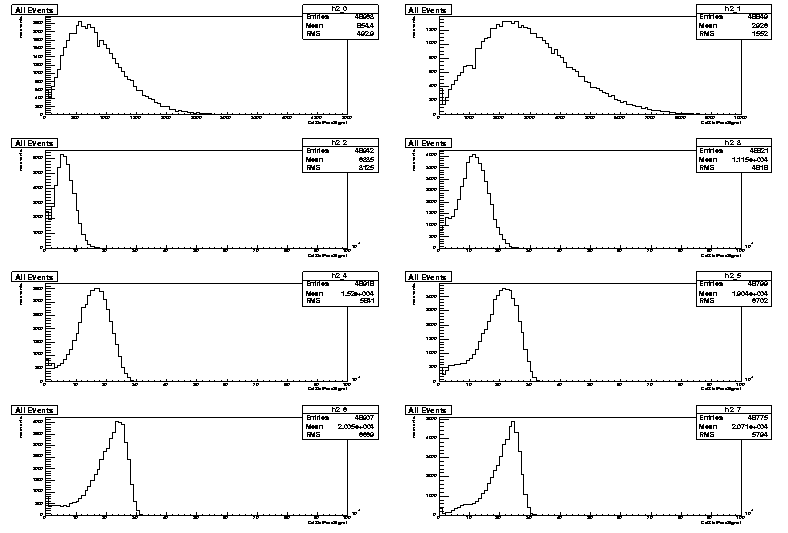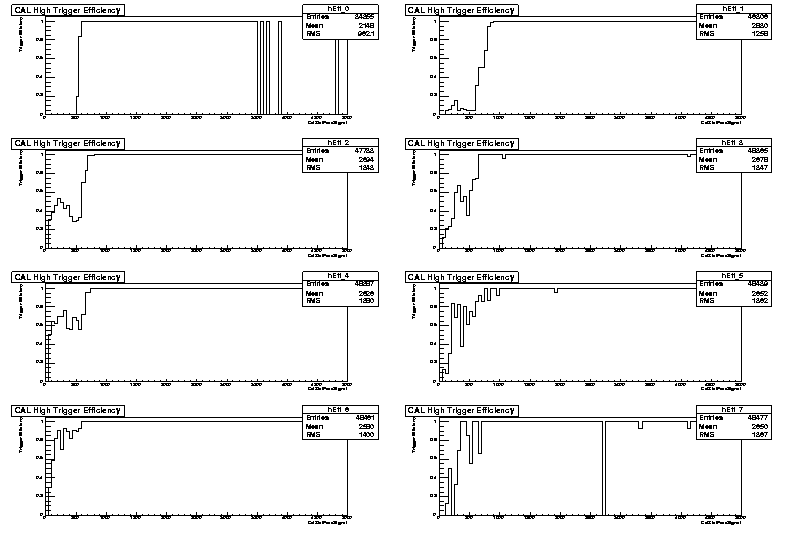Objective
At the first beamtest workshop in Pisa in March 2006, I (=Dave Smith) presented 5 studies that the CAL experts (=mainly Sasha Chehtman) thought should be done. You can flip through http://glast.pi.infn.it/glastdocs/cernbeamtest/workshop/slides/CALstuff.ppt
The five studies are
1) excercise the FHE triggers in realistic conditions and quantify their response ;
2) Check and refine the intercalibration of the Lex8, Lex1, Hex8, Hex1 ranges ;
3) Verify the performance of the autorange feature (ULD circuit) ;
4) Study how the non-linearity corrections obtained using charge injection data fare when applied to scintillation signals ;
5) Quantify the pedestal recovery after large charge deposits in the photodiodes ;
Here is who is doing which:
(1) & (3) are being pursued by Tomi & Jan, with Thierry, Denis, & Dave kibbitzing heavily.
(2) is well underway by Fred & Thierry and will appear at https://confluence.slac.stanford.edu/display/BeamTest/Calibrations.
(4) & (5) require large energy deposits and are primarily SPS studies, even though a PS pre-study would be useful, given that time may be tight at the SPS. Denis may undertake (5), to be confirmed.
As these studies mature they will hopefully spawn separate pages. For now, the rest of this page is for (1), the FHE trigger study.
Light yield assymmetry (J. Conrad)
Using the runs 700000703-700000712, which scanned the logs in the y coordinate for Tower 2 (5 GeV electrons), a plot of the assymetry- position correlation was produced.
Bottom line: it looks ok (I'd say), (see attachment).
Update: added corresponing plot for Tower 3 (runs 700000713-700000723) (JC)
Calorimeter autorange study for PS (T. Ylinen & J. Conrad)
Looking at reprocessed 4-range readout runs 700000700-700000750, provided by T. Reposeur, the performance of the autorange at PS was studied. The feature seen in a ion run at GSI could not be seen in this study. See attached presentation (ppt).
Calorimeter autorange study for SPS (T. Ylinen)
Looking at reprocessed 4-range readout runs 700001789, 700001791, 700001795, 700001799 and 700001801, the performance of the autorange at SPS was studied. The feature seen in a ion run at GSI could not be seen in this study either. See attached presentation (ppt).
FHE study at SPS (J. Conrad & N. Karlsson)
FHE runs taken at 282 GeV (electrons)
1952-1956: FHE thr: 0.5 - 2 GeV x = 201.17, y = 40, z = -47.7
1962-1970: FHE thr: 0.5 -2 GeV x= 603, y = 41, z = 1
The variables used are
CalReq[tow][lay][end] (Trigger request send, TEM diagnostics) (SVAC tuple)
CalXtalFaceSignal[tow][lay][log][end] (Calibrated energy)
The maximum in each layer of CalXtalFaceSignal has been taken
First results for run 700001952:
max_layer(CalXTalFaceSignal) for layer 1 (h2_0) to 8 (h2_8). Note the difference in x scale !!
FHE trigger efficiency (as seen by the TEM diagnostics) for layer 1 - layer 8.
Latest results
See also the following PowerPoint presentations in attachments for the latest results:
Run_700001952.ppt
Run_700001953.ppt
(I didn't manage to create links, they always ended up as add page link)
Data Taking Configurations and Relevant Runs
The FHE trigger study requires TEM diagnostics to be ON and a high energy beam to deposit lots of energy. Further, we need a series of at least 3 different energy FHE discriminator settings files. 0.5, 1, and 2 GeV would be good. Johan Bregeon will prepare these. For his 1 GeV examples see http://www.slac.stanford.edu/exp/glast/ground/LATSoft/nfsLinks/u37/BeamTest06/rawData/700000770/latest_G15_MeV1000_fhe_CAL_FM101.xml
I'm not sure how much statistics we'll need... Nota bene, as of this writing we have yet to see FHE fire at the PS testbeam! The above settings files went in for only run 770, taken with 5 GeV electrons this afternoon, and no CAL HI triggers were recorded. Other urgencies have precluded our making progress on this...
Update 07/29 (JB) : Last night we investigated and found a feature of the end2endBT script, which consequence is that the GCFE config_1 register is overwritten using the content of the lates_trg_FMxxx.xml files. The registers were set so as to disable CAL_HI. We updated the lates_trg_FMxxx.xml to 0x7 (mandatory value to enable CAL_HI and CAL_LO) and were able to see the CAL_HI firefing as expected. A run was done with the CU at 90deg to have high energy deposit and we could check that the CAL_HI trigger request fall nicely within the trigger windows (see that nigh shift confluence page). The conclusion is that from run 700000820 the CAL_HI trigger is enabled and should fire asap.
Update 07/31 (JB) : we now have the following FHE thresholds in MeV associated with the following BT configurations :
FHE(MeV) BT-#
500 17
750 18
1000 16
1500 19
2000 20
Please check the confluence DataTaking>Configuration page to see the details of these configurations. All the threshold files have been generated with the latest version of CalibGenCAL (v4r2p4?) and they passed the validation scripts.
So as soon as the beam is ready we can start study the FHE efficiency.
Update 07/31 (JB) : Trigger timing issue
A couple of nights ago we aligned the trigger primitives, so that now TKR, CAL_LO and CAL_HI triggers are aligned with the begginning of the trigger
window that is in our case always opened by the external trigger. We actually aligned the mean of the distribution with the 0 of the trigger
window so as to be sure that our TACK_DELAY values are correct. What we have seen in the first data (runs 820-821) is that the trigger primitive
timing distributions are quite wide, especially the CAL_HI one, so that after the alignment we only have half of the CAL_HI trigger request issued
within the trigger window. To be more efficient in the study of CAL_HI triggers, we could possibly adjust the ext_delay and tack_delay values so as to make sure that all the trigger primitive requests fits well inside the trigger window. This can be done quite easily adjusting the parameters in the BT configuration.
Please some CAL experts, tell me as soon as possible if that's usefull to do or not...
Update 08/02 (CS) : BT configuration numbers changed: Tkr Treq delay se to 8 and Cal Treq delay set to 6
FHE(MeV) BT-#
500 17
750 18
1000 19
1500 20
2000 21
Predictions from MC Simulations
My Geant 3 simut 4
Possible Experimental Backgrounds
In the attachment
Results and Discussions
In the attachment

